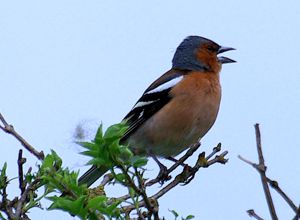


The Chaffinch is one of Nottinghamshire's best known and commonest birds, one of its old Nottinghamshire names is Spink, after its main call.
The Chaffinch breeds most densly in mature deciduous woodland, but it also breeds in coniferous woods, hedgerows, parks and gardens. In the autumn and winter the resident Chaffinches are augmented by continental birds. While the resident Chaffinches often remain close to their breeding territory at this time, the continental visitors feed in large flocks on farmland and roost communally.(The Atlas of Wintering Birds in Britain and Ireland {1986})
As a breeding bird the Chaffinch has slightly increased its numbers over the past 10 years and by about 30% in the last 13 years (1995–2007) (The BTO's Breeding Bird survey 2008). In the years around 1960 the population suffered a decline from the toxic newly invented seed dressings.
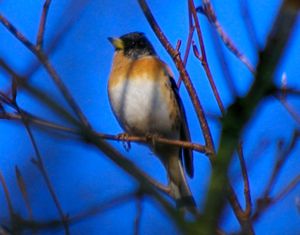
The Brambling is a purely winter visitor to Nottinghamshire. The numbers in the county depend on the harshness of the weather and the availability of food in Scandinavia and the amount of beechmast available in Nottinghamshire. If the beechmast runs out then they will either move on or feed in the open fields. Sterland & Whitaker in the Descriptive List of the Birds of Nottinghamshire{1879} say that the Brambing was a "constant winter visitor in the north of the county."
Bramblings can be found in the winter feeding under beech trees with Chaffinches and Great Tits, these include places such as the Sherwood Forest Park area, Clumber Park, Annesley and regularly at Sutton Lawns Park. They sometimes use bird feeders at the Nature Centre at Centre Parks.
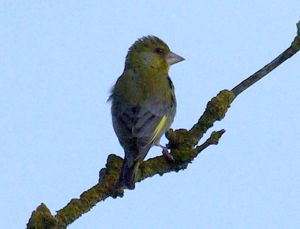
The Greenfinch is a common Nottinghamshire resident bird. It inhabits parks, gardens, farmland hedgerows and mature gravel pit margins, anywhere really with trees and bushes. An old Nottinghamshire name for the Greenfinch is Green Linnet. Greenfinches are mainly resident and don't move very far and there is little immigration into Nottinghamshire in the winter.
Sterland & Whitaker in the Descriptive List of the Birds of Nottinghamshire{1879} considered the Greenfinch to be "more numerous in summer than in winter". The Greenfinch numbers have increased by about 25% in the last ten years, possibly because of its increased use of garden bird feeders, and the increase in wildlife-friendly practices by some farmers.
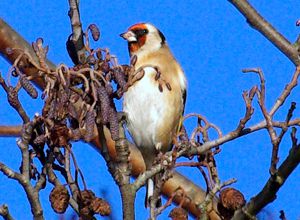
Goldfinches are considered to be a common resident in Nottinghamshire. Their habitat is rough ground roadside margins, gravel pit edges, parks and gardens. Having a thinner beak than many other finches they can feed on seeds such as thistle which are denied to the other finches.
Sterland & Whitaker in the Descriptive List of the Birds of Nottinghamshire{1879} thought the Goldfinch to be common in many parts of the county. The population of Goldfinches suffered a decline in the late 1970s – mid 1980s but since then have doubled in numbers.
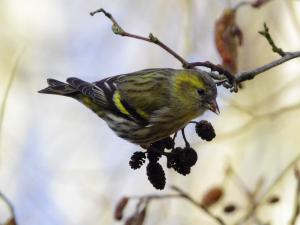
Siskins have enjoyed a good increase in numbers as a winter visitor to Nottinghamshire since W. J. Sterland wrote in the Descriptive List of the Birds of Nottinghamshire{1879} that it was only a rare winter visitor, coming at uncertain times, but always in large numbers
. He only saw it for three winters in his long birdwatching period. Now it is present in flocks of 40 plus every winter, and has started to breed in the county this century.
Breeds in conifer plantations which could account for its increase in numbers. In winter feeds on alder seeds and so any area with a few of these trees has the potention to attract a flock. Places include Wollaton Park, Rufford and some replanted old pit tops.
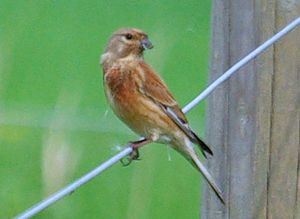
Sterland & Whitaker {1879} considered the Linnet to be abundant in the mid nineteeth century but it is not as common at the start of the twenty first century, mainly because the weedy areas it needs for food are so much less and it hasn't learnt the habit of attending feeders as many other finches have done. In fact the population has declined by around 75% since 1965 (Breeding Birds in the Wider Countryside) and in the East Midlands has declined by 50% in the last 13 years (1995–2007) (The BTO's Breeding Bird survey 2008). The reason for this may be the lack of weed seeds, due to changing agricultural methods and the increased use of herbicides. However other seed eating finches such as Greenfinches are increasing. A possible reason for the conundrum may be that Linnets like open country and the Greenfinches use hedges and field edges more.
An old Nottinghamshire name for the Linnet was Brown Linnet, to distinguish it from the Green Linnet (Greenfinch), it was also a popular cage bird along with the Goldfinch.
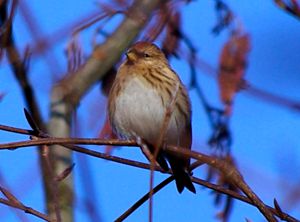
The Lesser Redpoll had a phenomenal increase in numbers in the late 1960s and early 1970s, since then the population has declined by over 95% (Breeding Birds in the Wider Countryside). Dobbs (The Birds of Nottinghamshire {1975}) says the Lesser Redpoll was classed as scarce in the 1950s, but in the 1960s became fairly common and a lot more widespread. Sterland & Whitaker {1879} say that the Lesser Redpoll was not uncommon in parts of Nottinghamshire in the nineteenth century.
The numbers of Lesser Redpolls have reduced by so much in the summer that it is doubtful if it is a breeding bird in Nottinghamshire any more, it is still fairly common in winter and it can be seen in areas such as Clumber Park and old pit tops, especially as young birch trees start to grow.
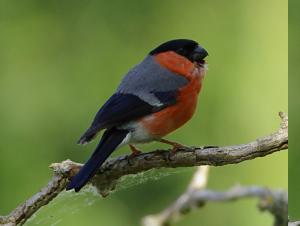
A fairly common resident in Nottinghamshire, it has however declined, for reasons unknown, in England by around 30% in the last 25 years (Breeding Birds in the Wider Countryside). Sterland in the Descriptive List of the Birds of Nottinghamshire{1879} considered the Bullfinch as abundant.
Sterland in The Birds of Sherwood Forest {1869} discusses the reason for the name Bullfinch and thinks it is because of its ‘bull’ neck and head, rather than the idea it was a corruption of the name ‘Budfinch’ a name from its spring–time habit of ripping buds from fruit trees.
The Bullfinch is an elusive bird in the breeding season, hiding in the foliage of woodland, only its piping call giving its presence away. In the autumn and winter it has to wander more to find plant and tree seeds especially ash keys, which it will now eat instead of its insect diet of the summer. In the spring the Bullfinch will eat a lot of leaf and flower buds and it used to be trapped on fruit farms to reduce the damage it did. It is only now trapped regularly in Britain, in Kent.
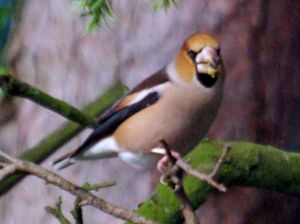
The Hawfinch is a scarce and local bird in Nottinghamshire and is almost confined to the Dukeries (Welbeck, Clumber Park and Rufford Abbey). The various smaller colonies in the south of the county are presumable extinct. Sterland in the Descriptive List of the Birds of Nottinghamshire{1879} thought the Hawfinch not uncommon in the Dukeries, whilst Whitaker in the same book bemoaned the fate of his peas being lost to their beaks. I also heard a similar story from one of my school teachers (a long time ago).
Sometimes there are influxes of Hawfinches from the continent and 2005 was one such year with birds being seen at several places in Nottinghamshire not normally associated with them, Clifton Grove was one place.
Any criticisms, corrections or comments to the author Derek Huskisson

This work is licensed under a Creative Commons Attribution-Noncommercial-Share Alike 2.0 UK: England & Wales License.